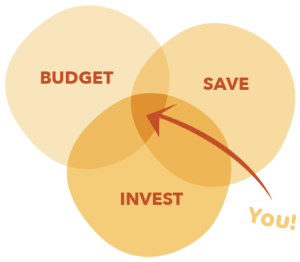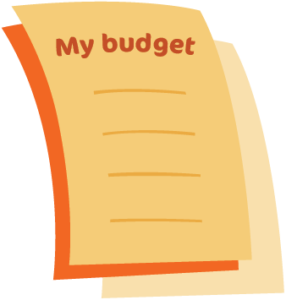With all of this chat about the cost of living crisis and more and more events happening that show us life can be very uncertain, it’s natural to think more about how you spend money and how to create some stability for yourself and your whānau.
Starting to track your finances and creating a monthly budget can help you feel like you’re on top of things, know where you’re spending money, and have your sights set on a bright future.
Why create a budget?
It can show you what you’ve got to work with and how to get through tough times.
It’ll help you understand your relationship to money and spending habits, keep a healthy credit score and work towards your savings goals or debt repayment.
It’ll show you what’s important to you and how to get there.
Best of all, it doesn’t require calculus or algebra, phew! No fancy equipment is needed – you could even go real old skool and write it up with pencil and paper.
What is a budget?
A budget is a way of telling your money where to go, rather than wondering where it went.
It isn’t about restricting what you spend. Instead, it’s a plan for how you want to spend your money, and can be a great tool to get you back on track if you’re struggling to stretch out your, pocket money, student allowance or weekly pay.
A budget is like a simple maths equation: X – Y = Z

There are some great budget templates out there you can use. Click here to see a completed (example) budget, and click on one of the following formats to download a black budget template in Microsoft Word, Google Docs or as a PDF. Fill in the budget template with your income and expenses and see how your money plan is looking.
Getting started – planning a budget
1. Add it all up – how much monthly income do you actually have to work with? Add up all the money coming in over the course of a month – this could be from your pocket money, a student allowance, wages or welfare benefits. It could also come from a side hustle, or any interest you have coming in from existing savings.
You may get some of your income as a bulk one-off payment for the year, so you’ll need to divide that amount by 12 months. You might also get payments like wages weekly, so you’ll need to work out the monthly amount ($X x 52wks / 12mths).
2. Then look at where your money is currently going – yes, that might mean some ‘forensic accounting’ looking at your past transactions on your bank statements. It’s the money you’re spending to buy stuff – make a list, or highlight your expenses on your last bank statement (and don’t forgot to include any expenses you pay cash for!).
It’ll make budgeting easier by helping you understand what regular expenses you have and how your money is being spent across different ‘needs and wants’.
3. Group your expenses into categories that make sense to you, for example, all your lunches, snacks, supermarket shops etc will be categorised under ‘food’. It’ll give you a picture of how much of your expenses is going towards essential fixed expenses (like rent), how much is going towards essential variable expenses (like transport to study or work) and how much is going to discretionary expenses (stuff that’s not necessary for day to day living, like socialising).
4. Create a budget – the goal is to spend less than you earn so take a good look to see where you can cut some of your spending back. If you do have some money left over, consider putting it into a separate savings account or set up a bank account to create an emergency fund. Generally an emergency fund, or money set aside for miscellaneous/unexpected expenses, is ~10% of your total weekly expenses.
5. Monitor your budget – this is what the ‘actuals’ and ‘difference +/’ column in our budget template are for. Write what you actually spent that week or month in the actuals column and then in the difference column write whether you were under or over your budgeted amount.
And remember, if you’ve been spending a certain amount on something, it doesn’t mean you have to keep spending that. Always try to reduce your expenses. If you’re struggling to get by, try some of the tips below.
First pro tip – pay yourself first!
Once you have a completed budget you’ll know how much you’ll need to set aside for your essential expenses (rent, utilities, food etc), and you’ll also know how much you have for savings. When you get paid, pay yourself first! Transfer that savings amount into your jam jar savings account before you’re tempted to spend it.
Choose a formula for all of your expenses and saving money
It can be helpful to pick a method or formula for how you split your net income and ultimately save money. We love the jam jars approach (mentioned above) with separate bank accounts which you can learn about here.
Another method is the 50:30:20 rule – where 50% of your budget goes towards ‘needs’ and essential living costs like rent and groceries, and expenses you can’t easily skip like transport to work or study or course materials; 30% goes towards ‘wants’ or nice-to-haves like socialising, memberships and subscriptions, and buying clothes; and 20% goes into savings. The key is to make it easy and realistic.
Putting your budget to work – track spending regularly
Pick a regular date to go through your budget. The start or end of the month is a good idea to do this, but you may want to build a new habit of regularly checking more often if your finances are fluctuating quite a bit, or if you’re still figuring out where your money is going.
You probably won’t get the balance right first time when it comes to your financial goals. If you overspend, look at ways to cut down your spending in your ‘wants’/discretionary costs, or maybe you need to lessen your savings expectations if it all feels a bit tight and hard to achieve.
Experiment and play around with it
We often try to lessen the time to reach our savings goal by increasing our monthly savings amount (and reducing our spending) but this might be a cause of stress and low daily satisfaction.
It can sometimes take time to find out the right balance between spending money and saving for you, which often comes through experimentation in your budget planning. It’s up to you to decide how much to set aside each month.
Some banks have a money tracking tool you can use to monitor your budget, and you could try a budgeting app like Booster, MoneyLover and PocketSmith too.
Bonus tip!
If you have a jam jar for a savings goal, or 20% of your income going into a savings account, AND you have a debt repayment or two – does that make good financial sense?
Learn more about debt and why you should address your debt repayment/s before you start saving here.
Keep on keeping on
The key thing to remember is that your personal budget doesn’t have to be perfect on the first go. Like anything, it gets easier with practice.
Money goals give you a sense of direction and encourage you to keep going, and really, that’s what budgets are all about.
Want to know more?
Sign up for the Life101 Launchpad here or learn more about the Better Budgeting workshop (and other financial workshops) here and prepare yourself to take on the world! Creating a budget and learning about saving are some of our most successful courses to date, with lots of practical ways to get you on the right track with budgeting, and therefore, your future happiness.

